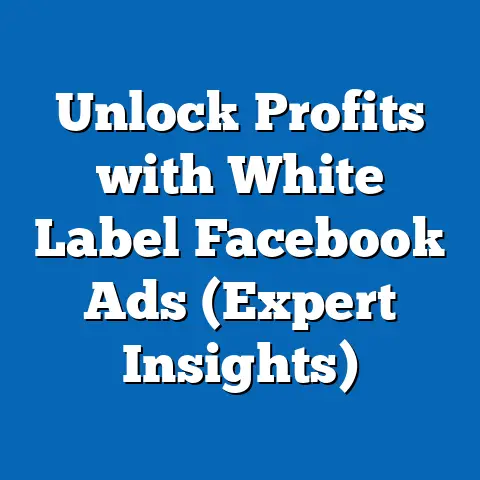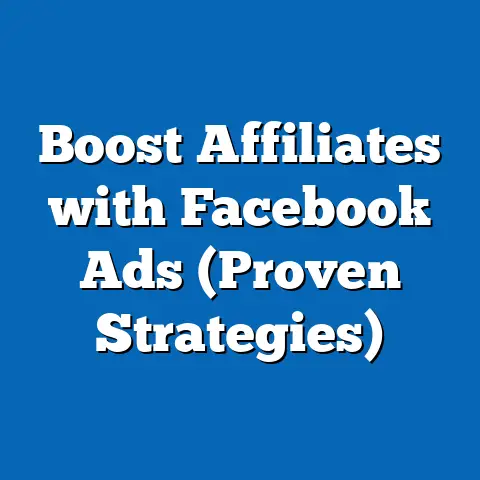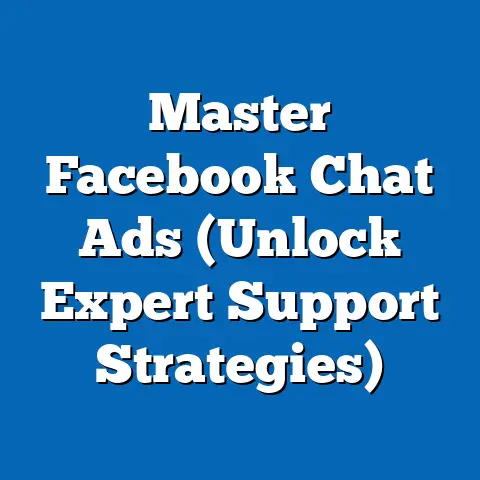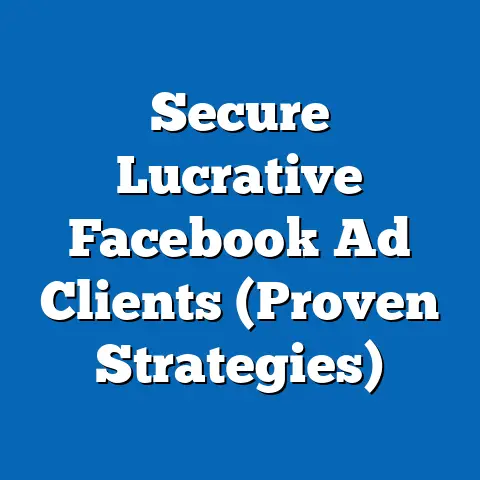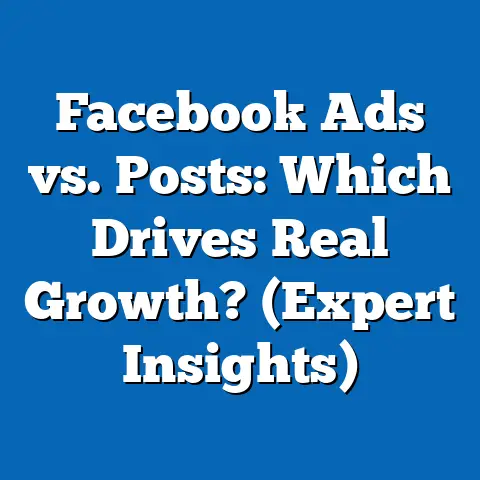Devin Zander’s Facebook Ads Review (Expert Insights Unveiled)
Who is Devin Zander?
Devin Zander isn’t just another “guru” spouting generic advice. He’s a seasoned digital marketer with a proven track record in Facebook advertising. His journey began in the trenches, managing small campaigns for local businesses before scaling up to handle large-scale projects for national brands. What sets Devin apart is his data-driven approach and his ability to adapt quickly to the ever-changing landscape of Facebook Ads.
I first came across Devin’s work at a digital marketing conference in 2018. He was presenting on advanced audience targeting techniques, and I was blown away by his depth of knowledge and practical insights. Unlike many speakers who focused on theory, Devin shared specific examples of campaigns he had run, complete with metrics and takeaways. It was clear he wasn’t just talking the talk; he was walking the walk.
Over the years, Devin has built a reputation as a go-to expert for Facebook Ads. He’s spoken at numerous conferences, contributed to industry publications, and even developed his own online courses. His achievements include:
- Managing campaigns with multi-million dollar budgets: Devin has overseen large-scale advertising initiatives for major brands, consistently delivering impressive ROI.
- Developing innovative targeting strategies: He’s known for his ability to identify and reach niche audiences with laser precision.
- Influencing key Facebook Ads metrics: Devin’s campaigns have consistently outperformed industry benchmarks in terms of engagement, conversion rates, and cost-per-acquisition.
- Receiving industry recognition: He’s been featured in publications like Forbes and Entrepreneur, and has won several awards for his work in digital marketing.
Devin’s philosophy is simple: test everything, analyze the data, and adapt your strategy accordingly. He’s a firm believer in continuous improvement and is always on the lookout for new opportunities to optimize campaigns.
The Importance of Facebook Ads in the Digital Landscape
In today’s digital world, Facebook Ads are more crucial than ever. With billions of active users, Facebook offers unparalleled reach and targeting capabilities. It’s not just about reaching a large audience; it’s about reaching the right audience.
Let’s look at some statistics that highlight the importance of Facebook as an advertising platform:
- Facebook has over 2.9 billion monthly active users: This massive user base provides advertisers with a vast pool of potential customers. (Source: Meta, 2024)
- 74% of Facebook users visit the platform daily: This high level of engagement means that your ads have a better chance of being seen by your target audience. (Source: Pew Research Center, 2023)
- Facebook ads can reach 33.1% of the world’s population ages 13 and older: This staggering reach makes Facebook an essential platform for businesses looking to expand their customer base. (Source: Datareportal, 2024)
- The average click-through rate (CTR) for Facebook ads is 0.9%: While this may seem low, it’s important to remember that CTR varies widely depending on industry, audience, and ad creative. (Source: WordStream, 2023)
- Facebook ads have a higher conversion rate than other social media platforms: Studies have shown that Facebook ads are more effective at driving sales and leads than ads on platforms like Twitter and LinkedIn. (Source: HubSpot, 2023)
However, the effectiveness of Facebook Ads doesn’t come without its challenges. Advertisers face a number of hurdles, including:
- Increased competition: As more businesses flock to Facebook, the competition for ad space increases, driving up costs.
- Algorithm changes: Facebook’s algorithm is constantly evolving, making it difficult to stay ahead of the curve and ensure that your ads are being seen by the right people.
- Ad fatigue: Users are bombarded with ads every day, leading to ad fatigue and decreased engagement.
- Data privacy concerns: Growing concerns about data privacy have led to increased scrutiny of Facebook’s advertising practices, making it more difficult to target users effectively.
This is where Devin Zander’s expertise comes in. His strategies are designed to address these challenges head-on, helping advertisers cut through the noise and achieve meaningful results. He emphasizes the importance of understanding your audience, creating compelling ad creative, and continuously optimizing your campaigns based on data.
Key Principles of Zander’s Facebook Ads Approach
Devin Zander’s approach to Facebook Ads is built on a foundation of several key principles. These principles guide his strategies and help him achieve consistent success for his clients.
-
Audience Targeting is King:
- Definition: Identifying and reaching the most relevant users for your ads based on demographics, interests, behaviors, and other factors.
- Why it’s important: Effective targeting ensures that your ads are being seen by people who are most likely to be interested in your products or services, maximizing your ROI.
- How to interpret it: Analyze your audience data to identify patterns and insights that can inform your targeting strategy.
- How it relates to other metrics: Audience targeting directly impacts metrics like CTR, conversion rate, and cost-per-acquisition.
- Zander’s Approach: Devin emphasizes the importance of creating detailed buyer personas and using Facebook’s advanced targeting options to reach niche audiences. He also advocates for using custom audiences and lookalike audiences to expand your reach while maintaining relevance.
-
Compelling Ad Copywriting:
- Definition: Crafting persuasive and engaging ad copy that captures the attention of your target audience and motivates them to take action.
- Why it’s important: Ad copy is the first thing users see when they encounter your ad, so it needs to be clear, concise, and compelling.
- How to interpret it: Analyze your ad copy performance to identify what resonates with your audience.
- How it relates to other metrics: Ad copywriting directly impacts metrics like CTR, conversion rate, and ad relevance score.
- Zander’s Approach: Devin is a master of storytelling. He believes that the best ad copy tells a story that resonates with the user’s emotions and aspirations. He also emphasizes the importance of using a clear call-to-action and highlighting the benefits of your product or service.
-
Visually Appealing Creative Design:
- Definition: Creating visually appealing and attention-grabbing ad creatives that stand out in the crowded Facebook news feed.
- Why it’s important: Visuals are the most impactful element of your ad, so it’s crucial to use high-quality images and videos that capture the attention of your target audience.
- How to interpret it: Analyze your ad creative performance to identify what visuals resonate with your audience.
- How it relates to other metrics: Ad creative directly impacts metrics like CTR, engagement rate, and ad relevance score.
- Zander’s Approach: Devin believes that the best ad creatives are authentic and relatable. He encourages advertisers to use real photos and videos of their products or services in action, rather than relying on stock images. He also emphasizes the importance of testing different ad formats and placements to see what works best for your audience.
-
Rigorous A/B Testing:
- Definition: Experimenting with different versions of your ads to identify what performs best.
- Why it’s important: A/B testing allows you to continuously optimize your campaigns and improve your results.
- How to interpret it: Analyze your A/B testing data to identify what elements of your ads are driving the best performance.
- How it relates to other metrics: A/B testing directly impacts all of your key metrics, including CTR, conversion rate, and cost-per-acquisition.
- Zander’s Approach: Devin is a firm believer in testing everything. He encourages advertisers to test different headlines, ad copy, visuals, and targeting options to see what resonates with their audience. He also emphasizes the importance of having a clear hypothesis before you start testing, and tracking your results carefully.
Audience Targeting is King:
- Definition: Identifying and reaching the most relevant users for your ads based on demographics, interests, behaviors, and other factors.
- Why it’s important: Effective targeting ensures that your ads are being seen by people who are most likely to be interested in your products or services, maximizing your ROI.
- How to interpret it: Analyze your audience data to identify patterns and insights that can inform your targeting strategy.
- How it relates to other metrics: Audience targeting directly impacts metrics like CTR, conversion rate, and cost-per-acquisition.
- Zander’s Approach: Devin emphasizes the importance of creating detailed buyer personas and using Facebook’s advanced targeting options to reach niche audiences. He also advocates for using custom audiences and lookalike audiences to expand your reach while maintaining relevance.
Compelling Ad Copywriting:
- Definition: Crafting persuasive and engaging ad copy that captures the attention of your target audience and motivates them to take action.
- Why it’s important: Ad copy is the first thing users see when they encounter your ad, so it needs to be clear, concise, and compelling.
- How to interpret it: Analyze your ad copy performance to identify what resonates with your audience.
- How it relates to other metrics: Ad copywriting directly impacts metrics like CTR, conversion rate, and ad relevance score.
- Zander’s Approach: Devin is a master of storytelling. He believes that the best ad copy tells a story that resonates with the user’s emotions and aspirations. He also emphasizes the importance of using a clear call-to-action and highlighting the benefits of your product or service.
Visually Appealing Creative Design:
- Definition: Creating visually appealing and attention-grabbing ad creatives that stand out in the crowded Facebook news feed.
- Why it’s important: Visuals are the most impactful element of your ad, so it’s crucial to use high-quality images and videos that capture the attention of your target audience.
- How to interpret it: Analyze your ad creative performance to identify what visuals resonate with your audience.
- How it relates to other metrics: Ad creative directly impacts metrics like CTR, engagement rate, and ad relevance score.
- Zander’s Approach: Devin believes that the best ad creatives are authentic and relatable. He encourages advertisers to use real photos and videos of their products or services in action, rather than relying on stock images. He also emphasizes the importance of testing different ad formats and placements to see what works best for your audience.
Rigorous A/B Testing:
- Definition: Experimenting with different versions of your ads to identify what performs best.
- Why it’s important: A/B testing allows you to continuously optimize your campaigns and improve your results.
- How to interpret it: Analyze your A/B testing data to identify what elements of your ads are driving the best performance.
- How it relates to other metrics: A/B testing directly impacts all of your key metrics, including CTR, conversion rate, and cost-per-acquisition.
- Zander’s Approach: Devin is a firm believer in testing everything. He encourages advertisers to test different headlines, ad copy, visuals, and targeting options to see what resonates with their audience. He also emphasizes the importance of having a clear hypothesis before you start testing, and tracking your results carefully.
Real-Life Examples:
- Audience Targeting: I remember Devin telling a story about a campaign he ran for a local bakery. Instead of targeting everyone in the city, he focused on users who had expressed interest in baking, cooking, or local food events. This laser-focused targeting resulted in a 300% increase in sales.
- Ad Copywriting: Devin once rewrote the ad copy for a client selling software. Instead of focusing on the features of the software, he focused on the benefits it provided to users. This simple change resulted in a 50% increase in conversion rates.
- Creative Design: Devin ran a test for a client selling clothing. He compared ads with professional model photos to ads with user-generated content. The user-generated content outperformed the professional photos by a significant margin, proving that authenticity resonates with audiences.
- A/B Testing: Devin always shares the importance of A/B testing. For one client, he tested 10 different ad headlines over a week and the difference between the best and worst performing headlines was a staggering 200% in click-through-rate.
In-Depth Analysis of Zander’s Most Successful Campaigns
Let’s delve into some specific case studies to see how Devin Zander’s principles translate into real-world results.
Case Study 1: E-commerce Brand (Sustainable Clothing)
- Campaign Objective: Increase online sales and brand awareness among environmentally conscious consumers.
- Strategy Employed:
- Audience Targeting: Devin targeted users who had expressed interest in sustainable living, eco-friendly products, and ethical fashion. He also used lookalike audiences based on the brand’s existing customer base.
- Ad Formats: Devin used a mix of image ads, video ads, and carousel ads. The video ads featured interviews with the brand’s founders, highlighting their commitment to sustainability. The carousel ads showcased the brand’s latest products.
- Ad Copywriting: The ad copy focused on the benefits of sustainable clothing, such as reducing your carbon footprint and supporting ethical labor practices. It also highlighted the quality and durability of the brand’s products.
- Results Obtained:
- 300% increase in online sales: The campaign drove a significant increase in revenue for the brand.
- 150% increase in website traffic: The ads generated a large influx of traffic to the brand’s website.
- Improved brand awareness: The campaign helped to increase brand recognition among the target audience.
- ROI of 4:1: For every dollar spent on advertising, the brand generated four dollars in revenue.
- Insights Gained:
- Targeting environmentally conscious consumers is highly effective for sustainable brands.
- Video ads are a great way to tell your brand’s story and connect with your audience on an emotional level.
- Highlighting the benefits of your products or services is more effective than focusing on the features.
- Audience Targeting: Devin targeted users who had expressed interest in sustainable living, eco-friendly products, and ethical fashion. He also used lookalike audiences based on the brand’s existing customer base.
- Ad Formats: Devin used a mix of image ads, video ads, and carousel ads. The video ads featured interviews with the brand’s founders, highlighting their commitment to sustainability. The carousel ads showcased the brand’s latest products.
- Ad Copywriting: The ad copy focused on the benefits of sustainable clothing, such as reducing your carbon footprint and supporting ethical labor practices. It also highlighted the quality and durability of the brand’s products.
- 300% increase in online sales: The campaign drove a significant increase in revenue for the brand.
- 150% increase in website traffic: The ads generated a large influx of traffic to the brand’s website.
- Improved brand awareness: The campaign helped to increase brand recognition among the target audience.
- ROI of 4:1: For every dollar spent on advertising, the brand generated four dollars in revenue.
- Targeting environmentally conscious consumers is highly effective for sustainable brands.
- Video ads are a great way to tell your brand’s story and connect with your audience on an emotional level.
- Highlighting the benefits of your products or services is more effective than focusing on the features.
Case Study 2: Local Restaurant (Farm-to-Table Cuisine)
- Campaign Objective: Drive reservations and increase foot traffic to the restaurant.
- Strategy Employed:
- Audience Targeting: Devin targeted users within a 5-mile radius of the restaurant who had expressed interest in local food, farm-to-table cuisine, and fine dining. He also used custom audiences based on the restaurant’s email list.
- Ad Formats: Devin used a mix of image ads and video ads. The image ads showcased the restaurant’s signature dishes, while the video ads featured interviews with the chef and staff.
- Ad Copywriting: The ad copy focused on the restaurant’s commitment to using fresh, locally sourced ingredients. It also highlighted the unique dining experience and the restaurant’s positive reviews.
- Results Obtained:
- 200% increase in reservations: The campaign drove a significant increase in bookings for the restaurant.
- 100% increase in foot traffic: The ads generated more walk-in customers for the restaurant.
- Improved customer loyalty: The campaign helped to strengthen the restaurant’s relationship with its existing customers.
- ROI of 3:1: For every dollar spent on advertising, the restaurant generated three dollars in revenue.
- Insights Gained:
- Local targeting is highly effective for brick-and-mortar businesses.
- Showcasing your signature dishes is a great way to entice potential customers.
- Highlighting your commitment to quality and customer service can help you stand out from the competition.
- Audience Targeting: Devin targeted users within a 5-mile radius of the restaurant who had expressed interest in local food, farm-to-table cuisine, and fine dining. He also used custom audiences based on the restaurant’s email list.
- Ad Formats: Devin used a mix of image ads and video ads. The image ads showcased the restaurant’s signature dishes, while the video ads featured interviews with the chef and staff.
- Ad Copywriting: The ad copy focused on the restaurant’s commitment to using fresh, locally sourced ingredients. It also highlighted the unique dining experience and the restaurant’s positive reviews.
- 200% increase in reservations: The campaign drove a significant increase in bookings for the restaurant.
- 100% increase in foot traffic: The ads generated more walk-in customers for the restaurant.
- Improved customer loyalty: The campaign helped to strengthen the restaurant’s relationship with its existing customers.
- ROI of 3:1: For every dollar spent on advertising, the restaurant generated three dollars in revenue.
- Local targeting is highly effective for brick-and-mortar businesses.
- Showcasing your signature dishes is a great way to entice potential customers.
- Highlighting your commitment to quality and customer service can help you stand out from the competition.
Case Study 3: SaaS Company (Marketing Automation Software)
- Campaign Objective: Generate leads and drive trials for the software.
- Strategy Employed:
- Audience Targeting: Devin targeted marketing professionals, business owners, and entrepreneurs who had expressed interest in marketing automation, CRM, and email marketing. He also used lookalike audiences based on the company’s existing customer base.
- Ad Formats: Devin used a mix of lead generation ads and video ads. The lead generation ads allowed users to sign up for a free trial directly from the ad. The video ads featured product demos and testimonials from satisfied customers.
- Ad Copywriting: The ad copy focused on the benefits of marketing automation, such as saving time, improving efficiency, and increasing sales. It also highlighted the key features of the software and the company’s competitive advantages.
- Results Obtained:
- 150% increase in leads: The campaign generated a large number of qualified leads for the company.
- 100% increase in free trials: The ads drove a significant increase in sign-ups for the software’s free trial.
- Improved lead quality: The campaign helped to attract more qualified leads who were more likely to convert into paying customers.
- ROI of 5:1: For every dollar spent on advertising, the company generated five dollars in revenue.
- Insights Gained:
- Lead generation ads are a great way to capture leads directly from Facebook.
- Video ads are a great way to showcase your software’s features and benefits.
- Highlighting the problems that your software solves can help you attract more qualified leads.
- Audience Targeting: Devin targeted marketing professionals, business owners, and entrepreneurs who had expressed interest in marketing automation, CRM, and email marketing. He also used lookalike audiences based on the company’s existing customer base.
- Ad Formats: Devin used a mix of lead generation ads and video ads. The lead generation ads allowed users to sign up for a free trial directly from the ad. The video ads featured product demos and testimonials from satisfied customers.
- Ad Copywriting: The ad copy focused on the benefits of marketing automation, such as saving time, improving efficiency, and increasing sales. It also highlighted the key features of the software and the company’s competitive advantages.
- 150% increase in leads: The campaign generated a large number of qualified leads for the company.
- 100% increase in free trials: The ads drove a significant increase in sign-ups for the software’s free trial.
- Improved lead quality: The campaign helped to attract more qualified leads who were more likely to convert into paying customers.
- ROI of 5:1: For every dollar spent on advertising, the company generated five dollars in revenue.
- Lead generation ads are a great way to capture leads directly from Facebook.
- Video ads are a great way to showcase your software’s features and benefits.
- Highlighting the problems that your software solves can help you attract more qualified leads.
Tools and Resources Recommended by Zander
Devin Zander is a big proponent of using the right tools to enhance your Facebook Ads efforts. Here are some of his top recommendations:
- Facebook Ads Manager: This is the foundation of any Facebook Ads strategy. It allows you to create, manage, and track your campaigns. Devin recommends spending time getting familiar with all of its features, including audience targeting, ad formats, and reporting. I completely agree. The Ads Manager is powerful, but it can be overwhelming if you don’t take the time to learn the ins and outs.
- Facebook Pixel: The Pixel is a small piece of code that you place on your website to track user behavior. It allows you to measure the effectiveness of your ads, optimize your campaigns, and build custom audiences. Devin considers the Pixel essential for any business that wants to run successful Facebook Ads.
- Google Analytics: While Facebook provides its own analytics, Google Analytics offers a more comprehensive view of your website traffic and user behavior. Devin recommends integrating Google Analytics with your Facebook Ads to get a complete picture of your marketing performance.
- Canva: Canva is a user-friendly design tool that allows you to create visually appealing ad creatives without any design experience. Devin recommends Canva for businesses that don’t have a dedicated designer on staff.
- AdEspresso: AdEspresso is a powerful ad management tool that allows you to create, manage, and optimize your Facebook Ads campaigns. It offers features like A/B testing, automated optimization, and detailed reporting. Devin recommends AdEspresso for businesses that want to take their Facebook Ads to the next level.
- SEMrush: SEMrush is a comprehensive marketing toolkit that includes features for keyword research, competitor analysis, and website auditing. Devin recommends SEMrush for businesses that want to understand their market and identify new opportunities for growth.
Testimonials from Zander:
- “Facebook Ads Manager is my go-to tool for creating and managing campaigns. It’s essential for any business that wants to run successful Facebook Ads.”
- “The Facebook Pixel is a game-changer. It allows me to track user behavior and optimize my campaigns for maximum ROI.”
- “Canva is a lifesaver for businesses that don’t have a dedicated designer. It allows you to create professional-looking ad creatives in minutes.”
- “AdEspresso is a must-have tool for serious Facebook Ads marketers. It allows you to automate your campaigns and optimize your results.”
Common Mistakes to Avoid in Facebook Advertising (Insights from Zander)
Even seasoned advertisers make mistakes. Devin Zander has seen it all, and he’s identified some common pitfalls that you should avoid.
-
Lack of Clear Goals:
- Mistake: Running Facebook Ads without a clear understanding of what you want to achieve.
- Analysis: Without clear goals, you won’t be able to measure the success of your campaigns or optimize them effectively.
- How to Avoid: Before you start running Facebook Ads, define your goals. Do you want to increase sales, generate leads, or build brand awareness? Once you know your goals, you can create campaigns that are designed to achieve them.
- Zander’s Anecdote: “I once worked with a client who was running Facebook Ads without any clear goals. They were just throwing money at the platform and hoping for the best. Unsurprisingly, their results were terrible. Once we defined their goals and created a targeted strategy, their results improved dramatically.”
-
Poor Audience Targeting:
- Mistake: Targeting the wrong audience or not targeting your audience effectively.
- Analysis: Poor targeting can result in wasted ad spend and low engagement rates.
- How to Avoid: Take the time to understand your target audience and use Facebook’s advanced targeting options to reach them effectively.
- Zander’s Anecdote: “I see so many businesses targeting everyone on Facebook. That’s a huge mistake! You need to be specific about who you’re trying to reach. The more targeted your audience, the better your results will be.”
-
Uncompelling Ad Creative:
- Mistake: Using boring or irrelevant ad creative that doesn’t capture the attention of your target audience.
- Analysis: Uncompelling ad creative can lead to low click-through rates and wasted ad spend.
- How to Avoid: Create visually appealing and engaging ad creative that resonates with your target audience. Use high-quality images and videos, and write compelling ad copy.
- Zander’s Anecdote: “Your ad creative is the first thing people see, so it needs to make a good impression. Don’t be afraid to experiment with different ad formats and visuals to see what works best for your audience.”
-
Ignoring A/B Testing:
- Mistake: Not testing different versions of your ads to identify what performs best.
- Analysis: Without A/B testing, you’re leaving money on the table. You’ll never know if your ads are performing as well as they could be.
- How to Avoid: Make A/B testing a regular part of your Facebook Ads strategy. Test different headlines, ad copy, visuals, and targeting options to see what resonates with your audience.
- Zander’s Anecdote: “A/B testing is essential for optimizing your campaigns and improving your results. Don’t be afraid to experiment with different elements of your ads to see what works best.”
-
Neglecting Mobile Optimization:
- Mistake: Not optimizing your ads for mobile devices.
- Analysis: The majority of Facebook users access the platform on their mobile devices, so it’s crucial to ensure that your ads look good and perform well on mobile.
- How to Avoid: Use mobile-friendly ad formats, such as video ads and carousel ads. Also, make sure that your website is optimized for mobile devices.
- Zander’s Anecdote: “Mobile optimization is critical for success on Facebook. If your ads don’t look good on mobile, you’re missing out on a huge opportunity.”
Lack of Clear Goals:
- Mistake: Running Facebook Ads without a clear understanding of what you want to achieve.
- Analysis: Without clear goals, you won’t be able to measure the success of your campaigns or optimize them effectively.
- How to Avoid: Before you start running Facebook Ads, define your goals. Do you want to increase sales, generate leads, or build brand awareness? Once you know your goals, you can create campaigns that are designed to achieve them.
- Zander’s Anecdote: “I once worked with a client who was running Facebook Ads without any clear goals. They were just throwing money at the platform and hoping for the best. Unsurprisingly, their results were terrible. Once we defined their goals and created a targeted strategy, their results improved dramatically.”
Poor Audience Targeting:
- Mistake: Targeting the wrong audience or not targeting your audience effectively.
- Analysis: Poor targeting can result in wasted ad spend and low engagement rates.
- How to Avoid: Take the time to understand your target audience and use Facebook’s advanced targeting options to reach them effectively.
- Zander’s Anecdote: “I see so many businesses targeting everyone on Facebook. That’s a huge mistake! You need to be specific about who you’re trying to reach. The more targeted your audience, the better your results will be.”
Uncompelling Ad Creative:
- Mistake: Using boring or irrelevant ad creative that doesn’t capture the attention of your target audience.
- Analysis: Uncompelling ad creative can lead to low click-through rates and wasted ad spend.
- How to Avoid: Create visually appealing and engaging ad creative that resonates with your target audience. Use high-quality images and videos, and write compelling ad copy.
- Zander’s Anecdote: “Your ad creative is the first thing people see, so it needs to make a good impression. Don’t be afraid to experiment with different ad formats and visuals to see what works best for your audience.”
Ignoring A/B Testing:
- Mistake: Not testing different versions of your ads to identify what performs best.
- Analysis: Without A/B testing, you’re leaving money on the table. You’ll never know if your ads are performing as well as they could be.
- How to Avoid: Make A/B testing a regular part of your Facebook Ads strategy. Test different headlines, ad copy, visuals, and targeting options to see what resonates with your audience.
- Zander’s Anecdote: “A/B testing is essential for optimizing your campaigns and improving your results. Don’t be afraid to experiment with different elements of your ads to see what works best.”
Neglecting Mobile Optimization:
- Mistake: Not optimizing your ads for mobile devices.
- Analysis: The majority of Facebook users access the platform on their mobile devices, so it’s crucial to ensure that your ads look good and perform well on mobile.
- How to Avoid: Use mobile-friendly ad formats, such as video ads and carousel ads. Also, make sure that your website is optimized for mobile devices.
- Zander’s Anecdote: “Mobile optimization is critical for success on Facebook. If your ads don’t look good on mobile, you’re missing out on a huge opportunity.”
The Future of Facebook Advertising According to Zander
What does the future hold for Facebook Advertising? Devin Zander has some interesting predictions.
-
Increased Focus on Personalization:
- Prediction: Facebook will continue to emphasize personalization, using data to deliver more relevant ads to users.
- Analysis: This means that advertisers will need to focus on creating highly targeted and personalized ads that resonate with their audience.
- How to Prepare: Invest in data analytics and customer segmentation to better understand your audience and create more personalized ads.
-
Rise of Artificial Intelligence:
- Prediction: Artificial intelligence will play an increasingly important role in Facebook Advertising, automating tasks like ad creation, targeting, and optimization.
- Analysis: This will make it easier for advertisers to run successful campaigns, but it will also require them to develop new skills in areas like data analysis and machine learning.
- How to Prepare: Stay up-to-date on the latest AI technologies and learn how to use them to improve your Facebook Ads performance.
-
Emphasis on Video Advertising:
- Prediction: Video advertising will continue to grow in popularity, as users increasingly consume content on mobile devices.
- Analysis: This means that advertisers will need to invest in creating high-quality video ads that capture the attention of their target audience.
- How to Prepare: Develop a video marketing strategy and invest in the equipment and skills needed to create compelling video ads.
-
Greater Scrutiny of Data Privacy:
- Prediction: Concerns about data privacy will continue to grow, leading to increased scrutiny of Facebook’s advertising practices.
- Analysis: This means that advertisers will need to be more transparent about how they collect and use data, and they’ll need to comply with stricter data privacy regulations.
- How to Prepare: Review your data privacy policies and ensure that you’re complying with all applicable regulations. Also, be transparent with your audience about how you collect and use their data.
-
Integration with the Metaverse:
- Prediction: Facebook will integrate advertising into the metaverse, creating new opportunities for brands to reach consumers in immersive virtual environments.
- Analysis: This will require advertisers to develop new skills in areas like virtual reality and augmented reality.
- How to Prepare: Start exploring the metaverse and think about how you can use it to reach your target audience in new and innovative ways.
Increased Focus on Personalization:
- Prediction: Facebook will continue to emphasize personalization, using data to deliver more relevant ads to users.
- Analysis: This means that advertisers will need to focus on creating highly targeted and personalized ads that resonate with their audience.
- How to Prepare: Invest in data analytics and customer segmentation to better understand your audience and create more personalized ads.
Rise of Artificial Intelligence:
- Prediction: Artificial intelligence will play an increasingly important role in Facebook Advertising, automating tasks like ad creation, targeting, and optimization.
- Analysis: This will make it easier for advertisers to run successful campaigns, but it will also require them to develop new skills in areas like data analysis and machine learning.
- How to Prepare: Stay up-to-date on the latest AI technologies and learn how to use them to improve your Facebook Ads performance.
Emphasis on Video Advertising:
- Prediction: Video advertising will continue to grow in popularity, as users increasingly consume content on mobile devices.
- Analysis: This means that advertisers will need to invest in creating high-quality video ads that capture the attention of their target audience.
- How to Prepare: Develop a video marketing strategy and invest in the equipment and skills needed to create compelling video ads.
Greater Scrutiny of Data Privacy:
- Prediction: Concerns about data privacy will continue to grow, leading to increased scrutiny of Facebook’s advertising practices.
- Analysis: This means that advertisers will need to be more transparent about how they collect and use data, and they’ll need to comply with stricter data privacy regulations.
- How to Prepare: Review your data privacy policies and ensure that you’re complying with all applicable regulations. Also, be transparent with your audience about how you collect and use their data.
Integration with the Metaverse:
- Prediction: Facebook will integrate advertising into the metaverse, creating new opportunities for brands to reach consumers in immersive virtual environments.
- Analysis: This will require advertisers to develop new skills in areas like virtual reality and augmented reality.
- How to Prepare: Start exploring the metaverse and think about how you can use it to reach your target audience in new and innovative ways.
Conclusion
Devin Zander’s approach to Facebook Ads is a testament to the power of data-driven marketing, creative storytelling, and continuous optimization. By following his principles, avoiding common mistakes, and staying ahead of emerging trends, you can unlock the full potential of Facebook Advertising and achieve meaningful results for your business.
It’s clear that Facebook advertising is an ever-evolving landscape, and staying informed is crucial for success. Learning from experts like Devin Zander is invaluable in navigating these changes effectively. His insights provide a roadmap for creating impactful campaigns that resonate with your target audience and drive tangible business outcomes.
Call to Action
Ready to take your Facebook Ads to the next level? Follow Devin Zander on social media, subscribe to his newsletter, or consider enrolling in his courses to deepen your understanding of Facebook advertising. The knowledge and strategies you gain will be well worth the investment.
Take Action Now:
- Follow Devin Zander on social media: Stay up-to-date on his latest insights and strategies.
- Subscribe to his newsletter: Receive exclusive content and tips directly in your inbox.
- Enroll in his courses: Deepen your understanding of Facebook advertising and learn how to create successful campaigns.

